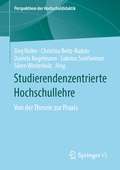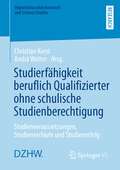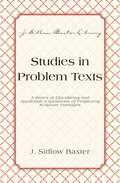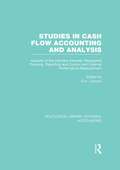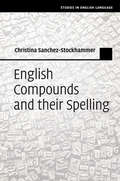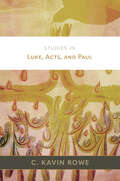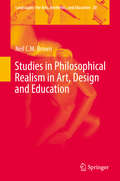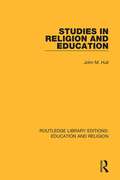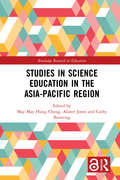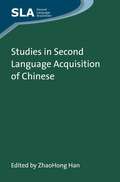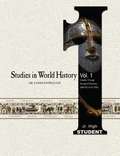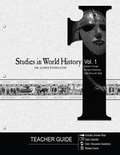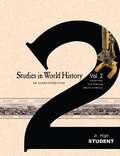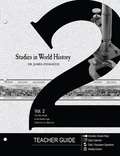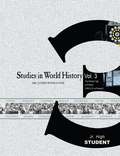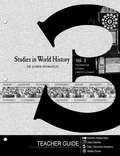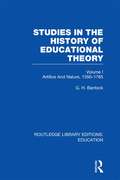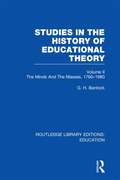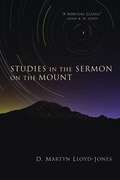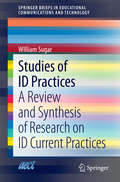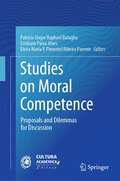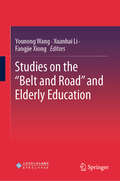- Table View
- List View
Studierendenzentrierte Hochschullehre: Von der Theorie zur Praxis (Perspektiven der Hochschuldidaktik)
by Jörg Noller Christina Beitz-Radzio Daniela Kugelmann Sabrina Sontheimer Sören WesterholzDer Sammelband geht den Fragen nach, was eigentlich studierendenzentrierte Lehre ist, welche konkreten Herausforderungen bei der Umsetzung einer studierendenzentrierten Lehre auftreten und wie eine solche Lehre angesichts dieser Herausforderungen umgesetzt werden kann. Aber auch: Welche Hürden haben sich bisher als unüberwindbar erwiesen, und wie können Lehrende damit umgehen?
Studierfähigkeit beruflich Qualifizierter ohne schulische Studienberechtigung: Studienvoraussetzungen, Studienverläufe und Studienerfolg (Higher Education Research and Science Studies)
by Christian Kerst Andrä WolterDer Band berichtet über empirische Forschungsergebnisse aus einer Längsschnittuntersuchung zu den Studienvoraussetzungen, zum Studienverlauf und Studienerfolg von beruflich Qualifizierten. Im Zentrum stehen solche Personen, die nicht über eine schulisch erworbene Studienberechtigung in die Hochschule gekommen sind. Das Kernergebnis besteht darin, dass diese Studierendengruppe ähnlich erfolgreich studiert wie andere Studierendengruppen auch.
Studies In Problem Texts: A Series of Elucidating and Applicable Expositions of Perplexing Scripture Passages (J. Sidlow Baxter Library)
by J. Sidlow BaxterDr. Baxter investigates, analyzes and interprets some of the more obscure passages of Scripture, shedding clear light upon much that heretofore has been bewildering. He himself has often expressed his indebtedness to the problem texts of the Bible because of the many hours of valuable searching and study that they have provoked in his life, and for the manner in which their study has disciplined himself and others in patience and painstaking investigation.
Studies in Cash Flow Accounting and Analysis: Aspects of the Interface Between Managerial Planning, Reporting and Control and External Performance Measurement (Routledge Library Editions: Accounting)
by Charles F. Klemstine Michael W. MaherThe fourteen papers in this volume, both unpublished and originally published between 1981 and 1990 offer a comprehensive selection of G. H. Lawson’s work and discuss the following: assessing economic performance ownership value creation pricing of non-competitive government contracts valuation of a business measurement of corporate performance according to cash flow.
Studies in English Language: English Compounds and Their Spelling (Studies in English Language)
by Christina Sanchez-StockhammerAnyone writing texts in English is constantly faced with the unavoidable question whether to use open spelling (drinking fountain), hyphenation (far-off) or solid spelling (airport) for individual compounds. While some compounds commonly occur with alternative spellings, others show a very clear bias for one form. This book tests more than sixty hypotheses and explores the patterns underlying the spelling of English compounds from a variety of perspectives. Based on a sample of 600 biconstituent compounds with identical spelling in all reference works in which they occur (200 each with open, hyphenated and solid spelling), this empirical study analyses large amounts of data from corpora and dictionaries and concludes that the spelling of English compounds is not chaotic but actually correlates with a large number of statistically significant variables. An easily applicable decision tree is derived from the data and an innovative multidimensional prototype model is suggested to account for the results.
Studies in Expansive Learning
by Yrjö EngeströmProfessor Engeström's exciting approach sees expansive learning as the central mechanism of transformation in societal practices and institutions. For researchers and practitioners in education, this book provides a conceptual and practical toolkit for creating and analyzing expansive learning processes with the help of interventions in workplaces, schools and communities. Chapters 1-3 situate the theory of expansive learning in the field of learning science. Chapters 4-8 contain empirical studies of expansive learning in various organizational settings (such as banks, schools and hospitals). In Chapters 9-10, the author looks at new challenges and possibilities arising from rapidly spreading 'wildfire' activities (disaster relief, for example) and from the methodology of formative interventions aimed at triggering and supporting expansive learning. This book provides an integrative account of recent empirical studies and conceptual developments in the theory of expansive learning, and serves as a companion volume to Learning by Expanding.
Studies in Luke, Acts, and Paul
by C. Kavin RoweC. Kavin Rowe&’s keenest essays on Luke, Acts, and Paul, collected into one volume How should scholars undertake New Testament interpretation? C. Kavin Rowe unfolds a careful, multidisciplinary approach across fifteen of his most incisive articles and chapters. Focusing on Luke, Acts, and Paul&’s letters, this authoritative collection exemplifies how to enrich exegesis through historical inquiry, philosophical reasoning, and theological reflection. Topics include: • The historical context of the Roman imperial cult • Ecclesial theology in Luke and Acts • The relationship between Luke and Acts • Paul and material culture Seeking the truth of Scripture requires more than a close reading of the text. Rowe&’s work on Luke, Acts, and Paul demonstrates how fruitful biblical interpretation can be when interpreters cross disciplinary boundaries. This volume is an indispensable addition to the libraries of scholars, students, and serious readers of Scripture alike.
Studies in Philosophical Realism in Art, Design and Education
by Neil C. M. BrownThis book fills a gap in the literature of 21st century international visual arts education by providing a structured approach to understanding the benefits of Philosophical Realism in art education, an approach that has received little international attention until now. The framework as presented provides a powerful interface between research and practical reconceptualisations of critical issues and practice in the domains of art, design, and education that involve implications for curriculum in visual arts, teaching and learning, cognitive development, and creativity. The book extends understanding of Philosophical Realism in its practical application to teaching practice in visual arts in the way it relates to the fields of art, design, and education. Researchers, teacher educators and specialist art teachers are informed about how Philosophical Realism provides insights into art, design, and education. These insights vary from clearer knowledge about art to the examination of beliefs and assumptions about the art object. Readers learn how cognitive reflection, and social and practical reasoning in the classroom help cultivate students' artistic performances, and understand how constraints function in students' reasoning at different ages/stages of education.
Studies in Religion and Education (Routledge Library Editions: Education and Religion #8)
by John M. HullFirst published in 1984. John M. Hull was a leading figure in the controversies which had surrounded religious education since the late 1960s. This book brings together in one volume 21 of his published papers and articles, which had previously appeared in journals, conferences, reports and books in Belgium, Australia, Canada, the United States, as well as the United Kingdom. This book is essential reading for all teachers, clergy, parents and students seriously concerned with the issues confronting religious education and Christian upbringing in our secular and pluralist world.
Studies in Science Education in the Asia-Pacific Region (Routledge Research in Education)
by Alister Jones Cathy Buntting May ChengConsistent with international trends, there is an active pursuit of more engaging science education in the Asia-Pacific region. The aim of this book is to bring together some examples of research being undertaken at a range of levels, from studies of curriculum and assessment tools, to classroom case studies, and investigations into models of teacher professional learning and development. While neither a comprehensive nor definitive representation of the work that is being carried out in the region, the contributions—from China, Hong Kong, Taiwan, Korea, Japan, Singapore, Australia, and New Zealand—give a taste of some of the issues being explored, and the hopes that researchers have of positively influencing the types of science education experienced by school students. The purpose of this book is therefore to share contextual information related to science education in the Asia-Pacific region, as well as offering insights for conducting studies in this region and outlining possible questions for further investigation. In addition, we anticipate that the specific resources and strategies introduced in this book will provide a useful reference for curriculum developers and science educators when they design school science curricula and science both pre-service and in-service teacher education programmes. The first section of the book examines features of science learners and learning, and includes studies investigating the processes associated with science conceptual learning, scientific inquiry, model construction, and students’ attitudes towards science. The second section focuses on teachers and teaching. It discusses some more innovative teaching approaches adopted in the region, including the use of group work, inquiry-based instruction, developing scientific literacy, and the use of questions and analogies. The third section reports on initiatives related to assessments and curriculum reform, including initiatives associated with school-based assessment, formative assessment strategies, and teacher support accompanying curriculum reform.
Studies in Second Language Acquisition of Chinese
by Zhaohong HanInterest in learning Chinese as an additional language has soared worldwide over the last ten years. Yet little is known about the learning process, and much less about what pedagogical strategies might facilitate or, otherwise, hinder it. This book thus aims to further understanding of the acquisition of Chinese as a foreign or second language. It brings together six independent studies which explore aspects of learning Chinese as an additional language across the domains of morphosyntax, pragmatics, cognitive capacity, interactional learning, and instructed learning via a variety of conceptual frameworks and methodological strategies. These studies, as well as the suggestions for future research, will be of great interest to second language acquisition researchers, graduate students and second language teachers of Chinese, as well as to curriculum developers and materials writers.
Studies in World History Volume 1 (Student)
by James P. StobaughCreation Through the age of Discovery (6000 BC to AD 1500) Chronologically based, but focused more on skill development Meant to be a 20 to 30 minute experience every day World history is combined with social studies in a one-year course. The Jr. High School student will see history come to life no matter what their pace or ability. Developed by Dr. James Stobaugh, the courses grow in difficulty with each year, preparing students for high school work. This is a comprehensive examination of history, geography, economics, and government systems. This educational set equips students to learn from a starting point of God's creation of the world and move forward with a solid biblically-based worldview. Volume I Covers - The Fertile Crescent, Egypt, India, China, Japan, Greece, Christian history, and more.
Studies in World History Volume 1 (Teacher Guide)
by James P. StobaughTeacher guides include insights, helps, and weekly exams, as well as answer keys to easily grade course materials! Help make your educational program better - use a convenient teacher guide to have tests, answer keys, and concepts! An essential addition for your coursework - team your student book with his convenient teacher guide filled with testing materials, chapter helps, and essential ways to extend the learning program.
Studies in World History Volume 2 (Student)
by James P. StobaughThe New World to the Modern Age (1500 AD to 1900 AD) Chronologically based, but focused more on skill development Meant to be a 30 to 45 minute experience every day World history is combined with social studies in a one-year course. The middle school student will see history come to life no matter what their pace or ability. Developed by Dr. James Stobaugh, the courses grow in difficulty with each year, preparing students for high school work. This is a comprehensive examination of history, geography, economics, and government systems. This educational set equips students to learn from a starting point of God's creation of the world and move forward with a solid biblically-based worldview. Volume II Covers - Clash of Cultures, Europe and the Renaissance, Reformation, Revolutions, and more.
Studies in World History Volume 2 (Teacher Guide)
by James P. StobaughTeacher guides include insights, helps, and weekly exams, as well as answer keys to easily grade course materials! Help make your educational program better - use a convenient teacher guide to have tests, answer keys, and concepts! An essential addition for your coursework - team your student book with his convenient teacher guide filled with testing materials, chapter helps, and essential ways to extend the learning program.
Studies in World History Volume 3 (Student)
by James P. StobaughThe Modern Age to Present (1900 AD to Present) Chronologically based, but focused more on skill development Meant to be a 30 to 45 minute experience every day World history is combined with social studies in a one-year course. The middle school student will see history come to life no matter what their pace or ability. Developed by Dr. James Stobaugh, the courses grow in difficulty with each year, preparing students for high school work. This is a comprehensive examination of history, geography, economics, and government systems. This educational set equips students to learn from a starting point of God's creation of the world and move forward with a solid biblically-based worldview. Volume III Covers - Modernism, the World at War, American Education, Evangelicalism, Modern Social Problems, and more.
Studies in World History Volume 3 (Teacher Guide)
by James P. StobaughTeacher guides include insights, helps, and weekly exams, as well as answer keys to easily grade course materials! Help make your educational program better - use a convenient teacher guide to have tests, answer keys, and concepts! An essential addition for your coursework - team your student book with his convenient teacher guide filled with testing materials, chapter helps, and essential ways to extend the learning program.
Studies in the History of Education Opinion from the Renaissance
by Simon S. LaurieFirst published in 1969. Routledge is an imprint of Taylor & Francis, an informa company.
Studies in the History of Educational Theory Vol 1: Nature and Artifice, 1350-1765 (Routledge Library Editions: Education)
by G H BantockThis book examines key theorists in depth in order to give some insight into cultural change as reflected in their curricular recommendations and in the interplay they reveal between the two fundamental educational concepts of ‘artifice’ and ‘nature’. The essays on the various theorists – Erasmus, Vives, Castiglione, Elyot, Montaigne, Bacon, Comenius, Locke and Rousseau can be read separately but the book also forms an integrated whole, with a continuity of themes explored from theorist to theorist. The book not only charts a historical development but also reveals much that may deepen our understanding of contemporary educational dilemmas.
Studies in the History of Educational Theory Vol 2: The Minds and the Masses, 1760-1980 (Routledge Library Editions: Education)
by G H BantockThis volume completes G H Bantock’s comprehensive study of educational thought, and its relationship to the broad development of European culture, from the time of the Renaissance to the present day. During the period under consideration, the new freedom from dogma and hierarchy allowed for the emergence of a large number of models of education intended to accommodate the autonomous personality and at the same time to meet the demand for educational expansion. The need to educate ‘the masses’ was increasingly recognized, and the dilemma posed by ‘mass civilisation and minority culture’ became acute as ‘liberal’ autonomy was increasingly threatened by new egalitarian and collectivist notions. The author considers the work of key theorists from the period, including such writers as Coleridge, Nietzsche and Tolstoy, all relatively neglected as educationists.
Studies in the Sermon on the Mount
by D. Martyn Lloyd-JonesA spiritual classic, this detailed and comprehensive study by one of the greatest expository preachers of our time explains Christ's teaching in the Sermon on the Mount and incisively applies it to the Christian life.With characteristic vigor and emotional vitality Dr. Lloyd-Jones presents a brilliant and detailed exposition of one of the best known but most frequently misunderstood passages of Scripture. Here is a comprehensive and exhaustive study of our Lord's words as recorded in Matthew chapter five. This beautiful portion of the Sermon on the Mount is carefully analysed, its contents outlined and thoughtfully arranged, and vastly rich and abundant truths are gleaned for the reader's spiritual nurture.The author brought a wealth of devoted study as well as a profound spiritual appreciation to the work of interpreting this greatest address of our delightful experience in meditation. It presents depth of thought in simple language and beauty of style and contains a veritable thesaurus of spiritual truths drawn from the entire Bible.
Studies in the Spectator Role: Literature, Painting and Pedagogy
by Michael BentonMichael Benton's book develops the concept of spectatorship as an answer to these questions. It explores the similarities and differences in our experiences of literature and the visual arts, and discusses their implications for pedagogy and their applications in cross-curricular work in the classroom. Teachers will find that, while many of the visual and verbal texts may be familiar, the approaches to them offer fresh insights and a rich agenda for the classroom. Shakespeare, Fielding, Hogarth, Blake, Wordsworth, Constable, Turner, the Pre-Raphaelites, Wilfred Owen, Paul Nash, Stanley Spencer, Ted Hughes and Seamus Heaney - the range of authors and artists discussed is both extensive and relevant to the National Curriculum and to post-16 and undergraduate courses.
Studies of ID Practices
by William SugarThis book provides a comprehensive analysis of cutting edge research studies on contemporary instructional design practices. Written for instructional designers, instructional technologists and researchers in the field, it provides state of the art, practically focused information and guidelines for designing curriculum and professional ID practice. The author compares professional instructional design practices with the competencies established by the International Board for Training, Performance, and Instruction to evaluate and investigate their effectiveness and increase the efficiency of the entire instructional design process.
Studies on Moral Competence: Proposals and Dilemmas for Discussion
by Patricia Unger Raphael Bataglia Cristiane Paiva Alves Elvira Maria P. Pimentel Ribeiro ParenteThis book shows how to use discussions of moral dilemmas as a strategy to develop moral competence in children and youth in educational environments using the Konstanz Method of Dilemma Discussion (KMDD). This method was developed by the German psychologist Georg Lind (1847-2021), who defines moral competence as an ability to solve problems and conflicts based on moral principles or values, through reflection, dialogue and deliberation, instead of using force, violence, deception and manipulation. According to Lind, this ability can be developed in children and youth through KMDD. The book has two parts. The first part brings together an original chapter written by Georg Lind about his decades of research on assessment and education of moral competence, and other 13 chapters written by different authors analyzing the theoretical foundations of moral development and moral competence as psychological constructs and their applications to different aspects of social life,as well as empirical research analyzing the application of different methods of dilemma discussion in educational contexts. The second part presents 20 moral dilemmas to be used in dilemma discussion sessions.Studies on Moral Competence: Proposals and Dilemmas for Discussion is the English edition of a book originally published in Portuguese for the Brazilian market and will be of interest to teachers and researchers interested in learning about the theoretical foundations and possible applications of an effective method to develop moral competence in educational environments. The translation was done with the help of artificial intelligence. A subsequent human revision was done primarily in terms of content.
Studies on the “Belt and Road” and Elderly Education
by Younong Wang Xuanhai Li Fangjie XiongThis book examines the rich connotations of the 'Belt and Road' initiative and the major theories, principles, measures, and propositions involved. It also explores various aspects of elderly education within the framework of the 'Belt and Road' initiative, including theoretical researches, teaching issues, overseas study tours, international qualifications of the professionals, and international cooperation. This book helps promote the advancement and development of elderly education (especially elderly education universities) in China, as well as in other parts of the world.
